This article is about the spiritual beliefs, histories and practices in Kwakwaka'wakw mythology. The Kwakwaka'wakw are a group of Indigenous nations, numbering about 5,500, who live in the central coast of British Columbia on northern Vancouver Island and the mainland. Kwakwaka'wakw translates into "Kwak'wala-speaking tribes." However, the individual tribes are single autonomous nations and do not view themselves collectively as one group.

The Kwakwa̱ka̱ʼwakw, also known as the Kwakiutl, are one of the indigenous peoples of the Pacific Northwest Coast. Their current population, according to a 2016 census, is 3,665. Most live in their traditional territory on northern Vancouver Island, nearby smaller islands including the Discovery Islands, and the adjacent British Columbia mainland. Some also live outside their homelands in urban areas such as Victoria and Vancouver. They are politically organized into 13 band governments.

Thomas Sterry Hunt was an American geologist and chemist.
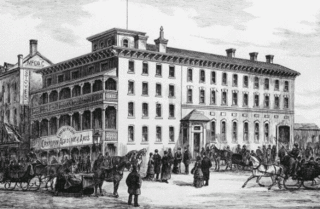
The Royal Canadian Academy of Arts (RCA) is a Canadian arts-related organization that was founded in 1880.

Charles Fraser Comfort, LL. D. was a Scotland-born Canadian painter, sculptor, teacher, writer and administrator.
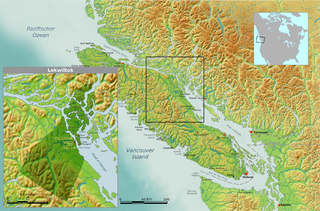
Laich-kwil-tach, is the Anglicization of the Kwak'wala autonomy by the "Southern Kwakiutl" people of Quadra Island and Campbell River in British Columbia, Canada. There are today two main groups : the Wei Wai Kai and Wei Wai Kum just across on the Vancouver Island "mainland" in the town of Campbell River. In addition to these two main groups there are the Kwiakah originally from Phillips Arm and Frederick Arm and the Discovery Islands, the Tlaaluis (Laa'luls) between Bute and Loughborough Inlets—after a great war between the Kwakiutl and the Salish peoples they were so reduced in numbers that they joined the Kwiakah—and the Walitsima / Walitsum Band of Salmon River.
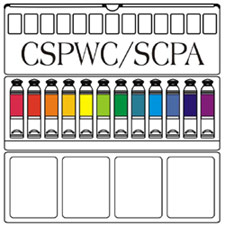
The Canadian Society of Painters in Water Colour, founded in 1925 is considered to be Canada's official national watercolour Society. Since the 1980s the Society has enjoyed Vice-regal Patronage from the incumbent Governor-General of Canada. Recognized by a long list of international exhibitions it is the Canadian equivalent of such other national societies as the American Watercolor Society of the United States, the Royal Watercolour Society of the United Kingdom, etc.
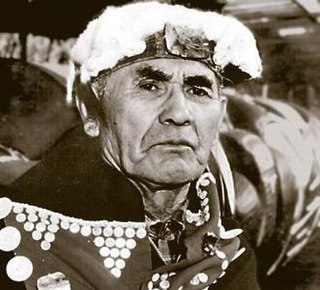
Chief Mungo Martin or Nakapenkem, Datsa, was an important figure in Northwest Coast style art, specifically that of the Kwakwaka'wakw Aboriginal people who live in the area of British Columbia and Vancouver Island. He was a major contributor to Kwakwaka'wakw art, especially in the realm of wood sculpture and painting. He was also known as a singer and songwriter.
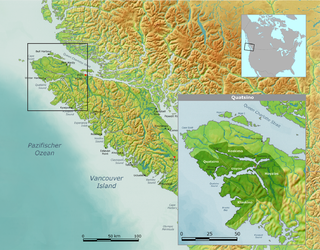
The Quatsino First Nation is the First Nations band government of the Gwat'sinux subgroup of the Kwakwaka'wakw peoples, based in the Quatsino Sound region on the west coast of northern Vancouver Island in British Columbia, Canada, focused on the community of Coal Harbour in Quatsino Sound. It is a member of the Kwakiutl District Council and, for treaty negotiation purposes, the Winalagalis Treaty Group which includes three other members of the Kwakiutl District Council (the Da'naxda'xw Awaetlatla Nation, Gwa'Sala-Nakwaxda'xw Nation, and the Tlatlasikwala Nation.
The Tlatlasikwala Nation is a First Nations band government based on northern Vancouver Island in British Columbia, Canada, focused on the community of Port Hardy, British Columbia in the Queen Charlotte Strait region. It is a member of the Kwakiutl District Council and, for treaty negotiation purposes, the Winalagalis Treaty Group which includes three other members of the Kwakiutl District Council (the Quatsino First Nation, the Da'naxda'xw Awaetlatla Nation, and the Gwa'Sala-'Nakwaxda'xw Nation.

The Kwakiutl First Nation is a First Nations government based on northern Vancouver Island in British Columbia, Canada, focused on the community of Port Hardy, British Columbia in the Queen Charlotte Strait region, and also known as the Fort Rupert Band, known in traditional Kwakwaka'wakw terms as the Kwagu'ł or Kwagyewlth. It is a member of the Kwakiutl District Council. It is currently in stage 4 of the British Columbia Treaty Process, having submitted a statement of intent in 1997.

George Hunt (Tlingit) was a Canadian and a consultant to the American anthropologist Franz Boas; through his contributions, he is considered a linguist and ethnologist in his own right. He was Tlingit-English by birth and learned both those languages. Growing up with his parents at Fort Rupert, British Columbia in Kwakwaka'wakw territory, he learned their language and culture as well. Through marriage and adoption he became an expert on the traditions of the Kwakwaka'wakw of coastal British Columbia.
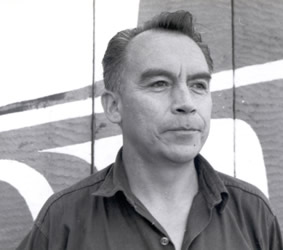
Henry Hunt was a First Nations woodcarver and artist from the Kwakwaka'wakw people of coastal British Columbia. He carved a number of totem poles which are on public display in Canada and internationally.

Richard Hunt DFA is a Canadian First Nations artist from coastal British Columbia.

Kwaguʼł are a Kwakwakaʼwakw tribe of the Indigenous peoples of the Pacific Northwest Coast from central British Columbia, on northern Vancouver Island. Their main community is called Tsax̱is or Fort Rupert. The ancestral language is Kwakʼwala, a language that is a part of the Wakashan language group. In their language, Kwaguʼł translates to Smoke-Around-the-World referring to the smoke that exited from the many bighouses in their villages.
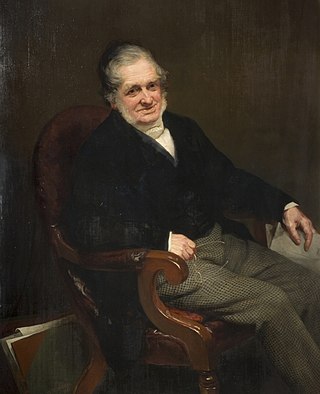
Samuel Lines was an English designer, painter and art teacher, and an early member of the Birmingham School of landscape painters.

Antoine-Sébastien Plamondon was an artist in Quebec, who painted mainly portraits and religious images, the latter commissioned primarily by churches in and around Quebec City. As a young man, he had traveled to France and studied painting in Paris for four years, with such portraitists as Jean-Baptiste Paulin Guérin.
Willie Seaweed was a Kwakwaka'wakw chief and wood carver from Canada. He was considered a master Northwest Coast Indian artist who is remembered for his technical artistic style and protection of traditional native ceremonies during the Canadian potlatch ceremony ban. Today, Seaweed's work can be found in cultural centers and corporations, art museums, natural history museums, and private collections. Some pieces are still in use by the Nak'waxda'xw tribe.
The K'ómoks First Nation, is the Indigenous band government of the Island Comox or K'ómoks people of Vancouver Island, British Columbia, Canada. Closely allied to the Cape Mudge and Campbell River First Nations, historically they were a Coast Salish people since integrated into Kwakwaka'wakw society. Originally part of the Laich-kwil-tach Council of Chiefs, which is a treaty society, they are now negotiating independently in the BC Treaty Process. They remain a member government of the Kwakiutl District Council.

Stanley Clifford Hunt is a Canadian, First Nations Kwakiutl artist from British Columbia.















